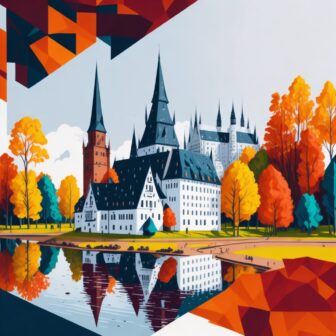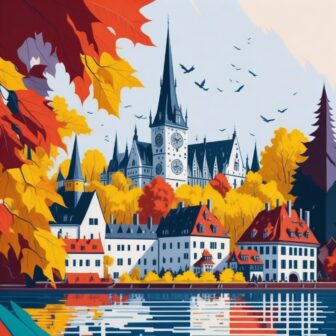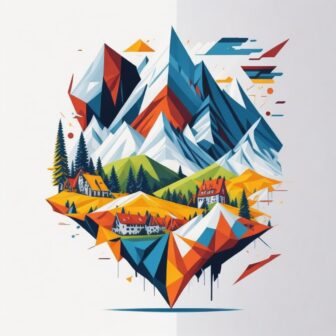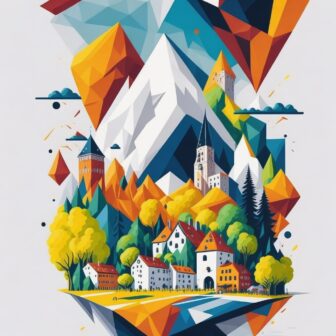25 Festivals and Customs in Germany
There are many festivals and customs in Germany. Each region has its own customs and festivals. I will present you the major festivals in Germany. I will also offer some historical backgrounds and stories. This way I hope that you will get to know Germany and its traditions even better.
Festivals and Customs in Spring
April Fools
On the April 1st, April Fools’ jokes have been played on friends and family in Germany since the 17th century.
Even today in Germany there is the joking custom of sending someone on April 1st with a funny assignment or a ridiculous message. Most of the time, some impossible things should be obtained such as mosquito grease, rooster eggs, goose milk or dried snow.
In Germany, people say: “On April 1st, you send the fools wherever you want.”
The phrase “send to April” was first found in Bavaria in 1618. It is not clear why this custom takes place on April 1st. Since the custom probably came to Germany from France, it could be related to the fact that Charles IX. In 1564 he changed New Year’s Day from April 1st to January 1st. Those who forgot this made their preparations in vain.
However, attempts have also been made to interpret and derive the April mail in a different way, for example from the date of the Roman Fools’ Festival or from the Augsburg Reichstag on April 1, 1530. Among other things, coinage was to be regulated there. Due to time constraints, however, this did not happen, so a special coin day was announced for April 1st. When April 1 came, this coin day did not take place after all. Numerous speculators who bet on this coin day lost their money and were even laughed at.
The custom is also attested in literature. Thus Goethe writes: “If you don’t want to lose March completely, don’t let April lead you. You have to get through the first of April, then some good things can happen to you.”
After all, April is known for its changeable weather and has become the image of impermanence. There is the weather rule “April, April, it doesn’t know what it wants”.
RELATED:
Germany in April: Weather, Fun Festivals & Travel Tips
Walpurgis Night - The Witch Festival
In the night from April 30th to May 1st is Walpurgis Night. Then, according to old folk belief, the witches should gather with the devil on the Brocken in the Harz Mountains. It is not known exactly how this superstition came about. Later the Catholic Church dedicated this day to St. Walburga. Even today, the witch festival is celebrated for tourists.
Easter
When the ancient Germans knew nothing about Jesus Christ, this spring festival was already being celebrated. With Christianity reaching Germany, Easter thus became the feast of the Resurrection, one of the most important Christian holiday. However many old customs have survived. This is why people like to hide boiled and brightly colored eggs at Easter. Many also say that the Easter Bunny does that. The children then have to look for the eggs. Raw eggs are also blown out, brightly painted and hung up as jewelry.
When Christianity came to the Germanic and Celtic peoples who lived in what is now Germany, the missionaries found there many deep-rooted customs that shaped the lives of the people.
Therefore, attempts were made to fill and transform the old customs with new beliefs. With the Christian Easter this went almost without any problems.
Since the passion of Christ was calculated for the spring time, the old church teachers resorted to the old spring festival of the Germans in order to transform it into a Christian one.
However, the exact date has been discussed for a long time. Only in the year 325, at the Council of Nicaea, was a uniform date set for the entire Christian church.
Easter is now celebrated on the first Sunday after the first full moon night since the beginning of spring.
The beginning of spring on March 21st is also called the equinox. As the name suggests, day and night are exactly the same length. From March 22nd, however, the days will be longer. The sun triumphs over winter and darkness.
Because Easter is a moon-based festival, it takes place on a different day between March 22nd and April 25th each year.
Easter eggs
Signs, images and language are the most important means of human understanding and communication. One of these signs throughout the world is the egg. It is a sign of life and vitality.
When you look at an egg from the outside, all you see at first is the hard shell. It seems lifeless. But when it gets enough warmth, either from a hen or an incubator, life suddenly stirs in the shell. The chick breaks the dead shell, breaks free and lives. So the shell was not the end, but rather a shelter for the life that could grow and develop behind it.
Earlier peoples, such as the ancient Egyptians, Greeks and Romans, laid eggs in the graves of their dead. With this they expressed that at some point a new life would begin and that death was only a long sleep.
The Germans and Celts also worshiped the egg. They recognized it as a symbol of nature waking up from hibernation. As the Christian faith spread, the egg took on a new meaning. Now it was seen as a sign of the resurrection.
Father’s Day
Although Ascension Day is a public holiday in Germany, that was turned it into “Father’s Day”. On this day, the men go on an excursion that often involves a lot of alcohol.
There used to be various customs on this day, especially among the farmers. A special prayer was asked on this day for a good harvest. On this day, people mainly ate “flying meat”, such as stuffed pigeons. Breads baked in the shape of birds were also a reminder that this day was something different.
May Festival
Who isn’t looking forward to May? Everything is green again outside and it’s getting warmer again. Spring is really here now! More than enough reason to celebrate.
The May Festival is very old. And it has remained very much alive to this day. There are different customs depending on the region.
The maypole is decorated on the eve of May 1st. You sit together and a small birch, spruce or a round hoop is decorated with colorful ribbons.
Larger maypoles often also bear symbols of important craftsmen (the pretzel symbolizing the baker, the tailor’s scissors, the carpenter’s axe, etc.) who erect the maypole. Sometimes there are also pictures of animals such as ox and donkey, horse and sheep, chicken and goose or funny figures appear.
When the maypole is erected, there is a celebration. And in the villages and towns, the “Dance into May” almost always takes place. There is dancing and partying until late at night.
On May Day, many workers still traditionally go to the May Day rallies organized by the unions. But fewer and fewer people go to these meetings today. It is better to go on a trip or a hike with the family.
In some areas there are joint parades and excursions or May festivals with music. In the evening, there is delicious May punch, a drink made from wine and sparkling wine with strawberries, apricots and aromatic woodruff.
May 1st is a public holiday in many countries as Labor Day. But above all, it is an important spring festival. Now the trees are green and it’s getting warmer. People go into nature. A maypole is erected in the villages and towns. The evening before, the dance into May is celebrated. There are many other customs in May.
Mother’s Day
In Germany, Mother’s Day is always celebrated on the 2nd Sunday in May. On this day, mothers receive presents from their children or the whole family goes to a restaurant to celebrate.
Festivals and Customs in Summer
Midsummer or Solstice Bonfire
The June 24th used to be the day of the summer solstice among the Germans, Celts and Slavs. It was one of their biggest festivals of the year. This is when the sun is at its highest, and they thought that was when it was at its most powerful. They wanted to honor fertility and celebrated a purification festival in which both water and fire customs played a special role.
On the old Midsummer’s Eve, when, according to old folk belief in Germany, witches and demons are loose and all sorts of strange things happen.
Today, in Germany, the mild summer nights are often used for celebrations. Where such celebrations still take place, the Midsummer or Solstice bonfire continues to be the focal point. You sing, dance and jump over the fire. And sometimes one sees burning wheels rolling down from the mountains, the so-called sun wheels. That was a custom of the Germans.
Pentecost - a celebration of joy
Pentecost has been celebrated since the third century. Always on the fiftieth day after Easter. Fifty means “pentecoste” in Greek, which is where the name “Pentecost” comes from. It is a happy festival. The festival has remained cheerful and contemplative at the same time to this day.
In Germany, Pentecost is a “double” public holiday. There is Whit Sunday and Whit Monday. Church services are often held outdoors on these days. People meet in nature, because summer is getting closer.
In contrast to Christmas and Easter, there are only a few customs at Pentecost. However, some old customs and customs are still maintained in some areas of Germany today. Churches are decorated with young birch green. There are the “Pentecost kicks” with horses, in which mostly only men take part. Parades in the open, games and pilgrimages take place. People often go on Whitsun hikes, and Whitsun bonfires are lit in some areas of Germany.
In village life, at Pentecost, cattle were led out to pasture for the first time or driven up to the alpine pastures. The shepherd boy who arrived last on the village square earned himself the nickname of a “Pentecostal lout”. In some areas, a “Peetle will be wrapped in green beech leaves so that he can no longer see and walk himself. He is then led through the village.
During the Pentecost the butchers led a fat ox through the village. The animal was decorated with flowers and garlands. He was slaughtered the next day. There was also a “penny ox” during the cattle drive. This was a brightly decorated ox leading the herd of cattle uphill.
Some old customs no longer exist today, or only rarely. Pentecost, however, has remained a popular holiday for everyone.
May/June
Feast of Trinity & Corpus Christi Procession
On the Sunday after Pentecost, Protestant Christians celebrate the Feast of Trinity.
The Catholic Christians celebrate their feast of Corpus Christi on the following Thursday. It originated in the Middle Ages when people were looking for a symbol that could visibly represent the presence of God. It was found in the Eucharist and then the bread was taken to symbolize it. There was a procession early on on Corpus Christi, which is still the focus of the festival today.
In the summer, when the farmers used to have to work a lot, there are only a few festivals. Today, this time is used for street and city festivals, among other things.
RELATED:
Germany in May: Weather, Fun Festivals & Travel Tips
Germany in June: Weather, Fun Festivals & Travel Tips
St. John’s Festival
After the start of summer on June 21st, however, the St. John’s Festival takes place on June 24th, the festival in memory of John the Baptist. Even before people in Germany became Christians, it was a festival of fire. The customs of this day are mostly very old. Today, some of these traditions still live on in northern and north-eastern Europe.
July/August
Fishermen and Shepherds Festivals
In some Catholic areas, the Assumption of the Virgin is celebrated on August 15th. On August 24th, St. Bartholomew’s Day, fishermen and shepherds used to celebrate their festivals. Even today there are still festivals in some cities on this day.
The Oberammergau Passion Festival
The history of the Passion Play begins as early as 1633. In the middle of the Thirty Years’ War, after months of suffering and dying from the plague, the residents of the small village of Oberammergau (Upper Bavaria) vowed to present the suffering, death and resurrection of Jesus on a stage every ten years. According to the village chronicle, not a single villager has died of the plague since this oath.
And so the Passion Play has been performed every ten years since 1634. It is played from May to October, four days a week. About 2,400 of the approximately 5,000 residents of the town are involved in the play as actors, musicians or in the choir. The first stage in 1634 was in the cemetery above the fresh graves of the plague victims.
RELATED:
Germany in July: Weather, Fun Festivals & Travel Tips
Festivals and Customs in Autumn
Das Erntedankfest - The Thanksgiving procession
When autumn comes, the many fruits in the garden and in the field are also harvested. Cereals, fruit and vegetables have ripened and we will soon taste them.
For many people who live in cities and don’t have their own garden, this is no longer visible today. They go to the supermarket and buy everything they need.
However the farmer and everyone who has a garden knows how long it takes for a small seed to grow into a large ear. And how long the tomato and pumpkin have to grow before they are ripe and taste delicious.
Harvest festivals exist in many cultures. In the past, people thanked the gods of nature.
When many people still worked in the countryside, there were many harvest customs. After bringing in the last fruits, thanks were given for a good harvest and for the good weather. The maids and servants presented gifts to the employer and his family, and then a big festival was celebrated with singing, dancing and games.
The Thanksgiving procession is still held in Germany today. Then beautifully decorated floats drive through the village, often accompanied by music. Grains, fruits and vegetables lie on carts pulled by horses or tractors. Children and adults often dress up in old costumes and demonstrate some of the old harvest customs. Heavy harvest wreaths and harvest crowns are often tied from grain stalks.
Early on there were also harvest festivals in the church, but it was not until the 19th century that harvest festivals became an official holiday in Prussia. This day it is usually celebrated on the first Sunday in October. In this period, in Germany, people decorate the churches with many colorful things from nature. Apples, pears, plums, potatoes, pumpkins, turnips, flowers and many other things are then placed on and around the altar. Bread is also part of it, or a few jars or cans of preserved fruit.
In the cities and larger towns, however, young people in particular are drawn to other things. At the fair you will find carousels, air swings, bumper cars, shooting galleries, sales booths, lottery stands, stands with food and drink and much more. The festival is loud and there is a lot of celebration.
Almabtrieb & Wine Festivals
In the Alpine region, the Almabtrieb has become a tourist attraction.
In the last days of October, the wine is harvested in some areas of Germany, especially on the Rhine and Moselle. People or machines harvest the grapes so that the wine can then be pressed. During this time, wine festivals take place in many places.
Oktoberfest
The Munich Oktoberfest, also known as the “Wiesn”, is the largest folk festival in the world and will take place this year from September 16th to October 3rd.
More than 6 million visitors flock to the festival every year. At the “Wiesn” around 6 million liters of beer are drunk every year, around 500,000 roast chickens and around 200,000 pairs of pork sausages are eaten; especially in the marquees of the traditional Munich breweries. The Hofbräufesthalle with about 10,000 seats is the largest tent.
The first Oktoberfest was held in 1810 in honor of the marriage of the Bavarian Crown Prince Ludwig to Princess Therese von Sachsen-Hildburghausen. The celebrations began on October 12, 1810 and ended on October 17 with a horse race. In the following years the festival was repeated, later extended and brought forward.
Oktoberfest is also celebrated far away from Munich. Around 2,000 Munich-style Oktoberfests are held all over the world. The biggest are in Blumenau/Brazil and Kitchener/Canada, each with around one million visitors, followed by Frankenmuth/Michigan-USA with around 350,000 visitors.
RELATED:
Oktoberfest in Munich, Germany
Germany in October: Weather, Fun Festivals & Travel Tips
Reformation Festival & Halloween
October 31 is a public holiday in the eastern federal states.
On the Reformation Day, people remember October 31, 1517, when Martin Luther nailed his 95 theses to the Castle Church in Wittenberg. This started a great movement that brought great changes throughout Germany and beyond. Through his work, the religious and political landscape of Germany changed fundamentally.
In recent years, the Reformation Festival has faced strong competition from America. More and more people are celebrating Halloween. It is a very old autumn festival of the Celts. They believed that on the night of November 1st, a prince of death would come with evil spirits to lead the people into his kingdom. To scare him off, the Celts put on terrifying masks and set up many lights. At the same time they often put nuts and fruit in front of the door to appease the “demons”.
Today, at this time in Germany, too, you can find illuminated hollow pumpkins on many houses, and children go from door to door for sweets or playing pranks. There are also parties where people dress up as witches or ghosts.
November
On November 1st the Catholic Church celebrates the Feast of All Saints‘ and on November 2nd or 3rd the Feast of All Souls’. In the cemeteries, the graves are beautifully decorated and candles are lit.
On November 11, children celebrate St. Martin’s Day, especially in the Catholic areas of Germany. It commemorates Saint Martin, who parted his cloak with his sword to help a freezing beggar. With lots of colorful lanterns that they made themselves beforehand, they parade through the streets in the dark and sing songs. A rider disguised as St. Martin leads the procession.
At the end of the procession, a bonfire awaits the children and often a Martins bag filled with lots of sweets.
During this time, the adults look forward to the Martin goose, a nice, stuffed roast goose.
With the Day of Repentance and Prayer, the Day of Mourning and the Sunday of the Dead, November is drawing to a close. Then the Advent and Christmas season begins.
RELATED:
6 Top Halloween Events in Germany
Germany in November: Weather, Fun Festivals & Travel Tips
Festivals and Customs in Winter
December
Christmas Markets
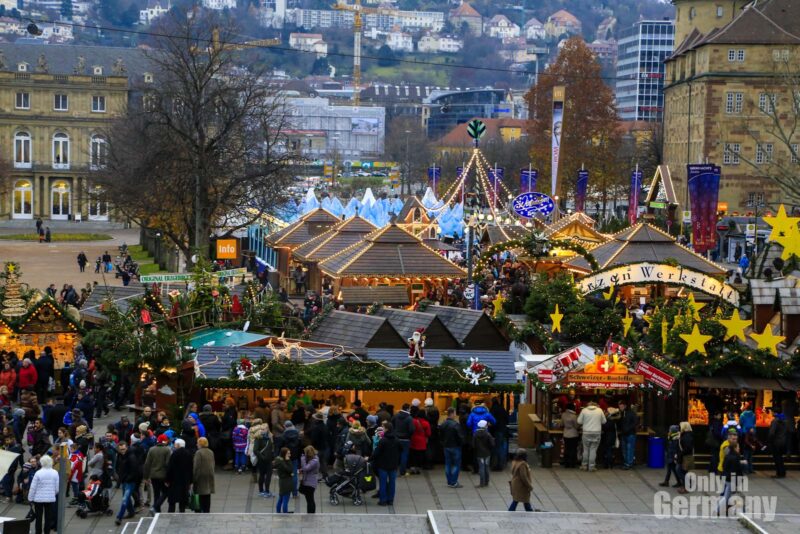
Advent is the time of waiting for Christmas. Many candles are burning in this time. Every Sunday in Advent, a candle is lit on an Advent wreath. When all four candles are lit, it will soon be Christmas. To make the wait easier, there is also the advent calendar. Each day another door is opened on the calendar. There are also many festivals, Christmas markets and musical performances during this time.
RELATED
German Christmas Traditions: What to Do in Germany for Christmas
Christmas Foods in Germany: What to eat and drink in Germany for Christmas
St. Nicholas festival
Many children look forward to the St. Nicholas festival on December 6th. Nicholas was a Christian bishop who was well loved for his generosity. Today, on this day, the children are given sweets and small gifts.
Christmas Eve
December 24th is finally Christmas Eve. Presents are distributed under the Christmas tree. Christmas is a real family celebration.
Christmas in the Ore Mountains
When the first snowflakes fall on the heights of the Ore Mountains, it’s not far to Christmas. Then many people come to the otherwise so quiet villages to experience something of this magic of the Christmas Ore Mountains.
The Ore Mountains are part of the Free State of Saxony, in the eastern part of Germany. It is one of the German low mountain ranges and is embedded between the Vogtland in the west and the Elbe Sandstone Mountains in the east. Part of the Ore Mountains lies on the Czech Republic side.
The Ore Mountains were originally sparsely populated. Many people there made a living from mining, particularly ore mining, from which the area takes its name. Places like Freiberg stand for this tradition. The highest elevation is the Fichtelberg at 1214 m.
At its foot is the winter sports resort of Oberwiesenthal. Many well-known Olympic champions came from here in the days of the former GDR. The steam train, which is rare in western Germany, also runs in this area. There are many small villages in the Ore Mountains, to which often only narrow roads lead through valleys and over hills.
The Ore Mountains are particularly beautiful in winter. It is true that it is very cold outside, and the freezing cold and the often roaring storms do not always make it so pleasant to be outdoors. But it’s all the nicer in the parlors.
If you walk the streets of the villages in December, you will see a lot of lighting in the windows. The light shines out of the houses beautifully. Lamps, figures, dolls and incense smokers, as well as carved miners are placed in the windows and also adorn the living rooms.
But also on the streets and squares of the towns and villages you can often find illuminated figures and so-called pyramids.
Here at Christmas time you can also see miners’ bands with brass bands roaming the streets, and colorful Christmas markets always attract visitors. You can then buy all kinds of handicrafts from the Erzgebirge, and the smell of roasted almonds and incense cones reminds you of the upcoming Christmas festival.
RELATED:
Germany in December: Weather, Fun Festivals & Travel Tips
New Year’s Eve Celebration
The year ends on December 31st. On New Year’s Eve you celebrate with friends and the end is always a colorful fireworks display. The new year has begun!
January
The time between Christmas on 25.12. and the New Year’s festival on 1.1. is a special time. It is also popularly known as the time between the years.
It all started with the change in the calendar. In the past, the so-called Julian calendar from 46 BC, which was based on the course of the sun, was used.
It was soon noticed, however, that this calendar was not entirely correct, and in 1582 it was approved by Pope Gregory XIII. changes. In this new Gregorian calendar, twelve days were added to what was actually December 24th. attached at the end of the year.
There were now two New Year’s days: the old New Year’s day on December 25th. and the beginning of the new year on January 6th.
New Year’s Day was later changed to January 1st. brought forward, but the time between the old and new beginning of the year was still called between the years for a long time.
This time of the end of the year was already a time of many customs and traditions in pre-Christian times. Evil was to be driven out, and there were certain things not to be done. People were unsure, and many wanted to know what the new year would bring. They used magic or tried to predict the future by pouring lead or reading coffee grounds. Many of these customs are still known today.
For many people, however, this is a time of rest and relaxation. They don’t have to work during this time, they visit friends or even go on vacation.
Sylvester - The New Year’s Day
On 12/31 is New Year’s Day. It is named after Pope Sylvester I, who died in 335 AD. In his time, Christianity became the Roman state religion.
The shops are only open until noon on this day. In the afternoon, many people prepare for joint festivals and celebrations.
On the last day of the year they celebrate in good company, and at midnight they wish a Happy New Year or toast the New Year with a glass of sparkling wine. Everywhere it starts to bang loudly, and all the church bells ring. Colorful fireworks are often seen. In the past, noise and bangs were used to drive away the evil winter spirits.
From one second to the next a new year begins. The name of the month January is reminiscent of the Roman god of beginnings: Janus, a god with two faces. He looks back and forward at the same time.
So many people think about the old year again during this time and ask themselves what the new year will bring for them. Others hope for old symbols of luck, such as the horseshoe, the four-leaf clover, the lucky pig or the chimney sweep.
The New Year’s Day
The first day of the year has always been a holiday. People visit families and friends. They exchanged gifts, New Year’s cakes, and wished happiness for the new year.
Otherwise one sleeps longer, some take a New Year’s walk or go to a New Year’s concert. A new calendar is hung. The new year has begun.
The Three Wise Men
Another feast day, which is mainly celebrated in southern Germany, is Epiphany on January 6th. It commemorates the three wise men from the East who followed the star to Bethlehem. Today you can still see the carol singers at this time, disguised as the three kings. They collect money for poor children in other countries and often get something to eat. January 6th is also known as Epiphany, the feast of the Epiphany of the Lord, the day of Christ’s baptism.
RELATED:
Germany in January: Weather, Fun Festivals & Travel Tips
February
German Carnival
Germany does not universally celebrate Carnival. The Rhineland is where it is celebrated by the most people. Cologne, Düsseldorf, and Mainz are well known for their celebrations. But other regions of Germany also commemorate this occasion. However, the name of the celebration is different there. It is known as “Fastnacht” or “Fasching”.
RELATED
Carnival in Germany – Ultimate Guide
Germany in February: Weather, Fun Festivals & Travel Tips


